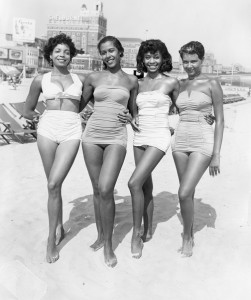Play raises issues of contemporary racism
An imitation, a desecration, a simulation of life. So the female, Afro-Deutschen character Schatsi is described in Bliss. USC professor Velina Hasu Houston’s play, which was performed Monday at the USC Fisher Museum of Art, however, is anything but an imitation of life. It’s the real deal.

Cultural beauty · Velina Hasu Houston’s play Bliss was performed as a book reading at the USC Fisher Museum of Art, which featured several photographs from the “Posing Beauty” exhibition. - Photo courtesy of USC Fisher Museum of Art
Directed by Jon Lawrence Rivera, Bliss, is set in familiar Los Angeles, where two mixed-race characters, Schatsi and Dagmar, come to terms with race and identity in a society where racial roles are clearly drawn.
Schatsi (Liz Vital) is of Tanzanian and German descent, as is her twin sister Dagmar (Tessa Thompson), famous for her role as Nyla in the 2010 Tyler Perry film For Colored Girls. The two grew up in Topanga Canyon, Calif., before moving to Los Angeles with their German mother, Inge, after the death of their African father.
There’s only one problem. Schatsi, blonde-haired and blue-eyed, resembles her German mother, while her sister Dagmar, yellow-skinned with “kinky” brown hair, resembles her Tanzanian father. As they move into a race-conscious society, they must reconcile who they really are against society’s perceptions.
Of mixed-descent herself, Houston was well equipped to write the play, which draws ideas from films like Imitation of Life (1959). After studying films of the early ’90s, Houston noticed a trend and asked herself, “Why is western cinema so fixated with the tragic nature of the mulatta?”
Houston was also able to draw on personal experiences; she grew up with a friend whose life paralleled that of her characters.
“One of these girls [who I grew up with] was blonde-haired and blue-eyed, but half-black,” Houston said in the post-performance Q&A. “For most of my career, I’d written about the tensions of Asians and blacks and Asians and whites. She asked, ‘When are you going to write about our family?’ So I started to look into it.”
Bliss focuses on the two protagonists with great detail to narrow in on these given issues. It is this specificity that enables the audience to visualize the performance as if it were a full-fledged production, despite the fact that the Visions and Voices event was a concert reading performance that featured no set, minimal lighting and actors on-book.
The play did, however, have the artsy, creatively abstract “Posing Beauty” exhibition that served as the backdrop for the reading and added to the play with its racial parallels.
Evidently, Houston relied on her own wit over that of a production designer, crafting dialogue rich with characterization. The writing created little need for movement for actresses Vital, Thompson, Elizabeth Ruscio and Vivia Font as they worked off the script and effectively conveyed emotions through their voices and facial expressions. The play spoke for itself.
“Even though I’m writing about a racially charged situation, the most important thing I wanted to talk about was this family,” Houston said. “That was something everyone could relate to.”
Family was not the only connecting point for the audience. Houston makes sure to include other relevant issues too, allowing modern audiences to establish firm connections. Specifically, she brings up how in a seemingly post-racial society, students still prefer to befriend those of their own race and how Americans call each other racial slurs with no thought of the larger implications.
Houston also hammers home the difficulty of being mixed in a culture where one can essentially be defined by race. She focuses on “uniqueness” and “separation.” For instance, in the opening sequence of the play, the girls plant a garden with their mother and talk of hybridization of plants, polka-dotted lady bugs and sing songs about loving the variety of color in their clothes, bringing mixed culture to light through motifs and symbols.
“What I’m trying to take out — until the end — is all notion of race,” Houston said. “All I’m talking about in the beginning is difference. Then slowly that [racial] language begins to slip into their language.”
A sense of magical realism is evident in her subplot. Based on Imitation of Life, the story of Honeychild centers around that of a mulatto girl. Born with extremely light skin, Honeychild spends her life trying to “pass” as white, turning her back on her black mother and her true identity.
A foil for the present-day character of Schatsi, Honeychild crawls out of the family’s old, broken-down television set and tries to impart words of wisdom to Schatsi, who ultimately doesn’t listen and gets into all sorts of trouble.
It is this story within a story and the close resemblance of racism in the past to racism today that makes the play so utterly complex.
